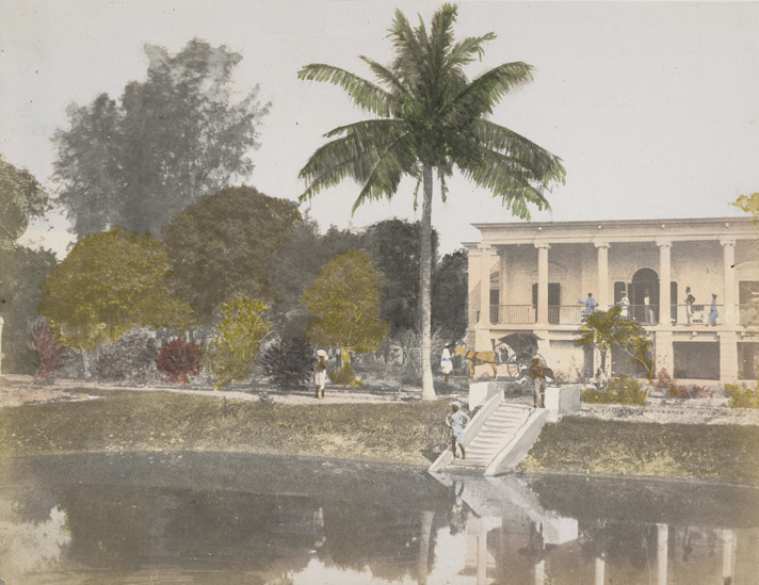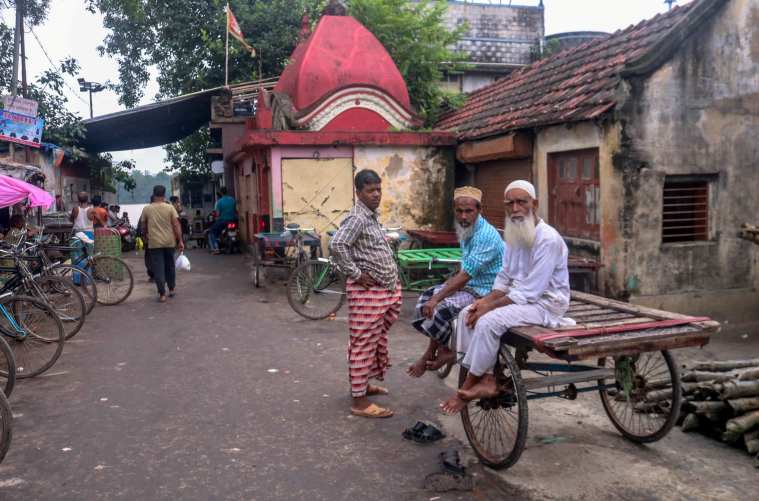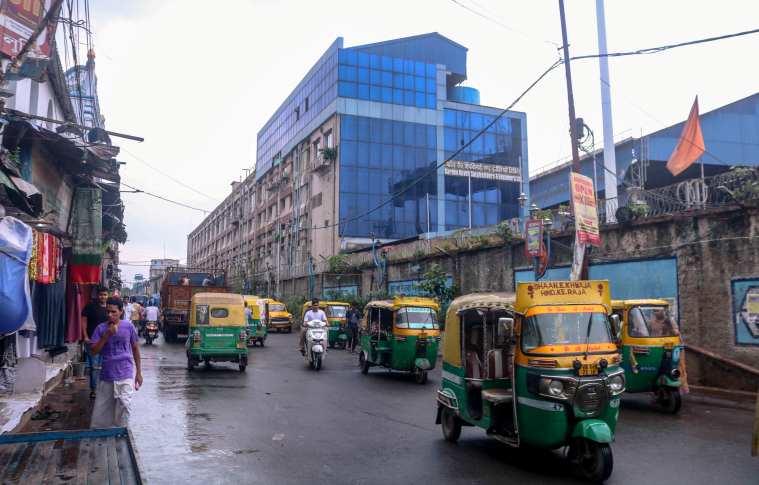If the constant flow of goods trucks and large vehicles don’t obstruct one’s view, it might just be possible to see past the chaos of Garden Reach to identify this Kolkata neighbourhood’s original purpose. Large mansions in a state of partial disrepair, yet astonishing examples of colonial architecture now serving as government offices and residences provide hints of what the original purpose of these buildings may have been. But the most imposing identity of this neighbourhood is the Hooghly river that skirts its embankments and how the river developed and shaped its environs over the years.
In his book ‘Calcutta Old and New’, historian H. E. A. Cotton writes that these “riverside villas” once served as the residences of wealthy merchants in the city. Cotton’s writings serve as one of the best-known documentations of 19th century Calcutta and a reading of this text indicates that by the time Cotton began documenting the city in the late 1890s, the city had changed enough for this development to find mention in the historian’s writings.
According to Cotton, Garden Reach served as the anchoring place for the Portuguese when they first “began to frequent Bengal about the year 1530”. The Portuguese, writes Cotton, chose Garden Reach because of its proximity to Satgaon, originally a Hooghly village so small that it was no more than a group of a few huts, yet one of the “two great centres of trade” along with Chittagong in the east.
By the 17th century, writes Cotton, Garden Reach had become an anchorage point for the sea-going vessels of the Portuguese. Cotton points to the writings of Eliza Fay, an English graphic letter writer who travelled extensively around the world, finding herself in a combination of scrapes and adventures, till she reached Calcutta in May 1780, with her husband Anthony Fay, a barrister. Soon after her arrival in the city, Fay wrote: “The banks of Garden Reach…are studded with elegant mansions, called garden-houses, surrounded with groves and lawns which descend to the water’s edge, and present a constant succession of whatever can delight the eye, or bespeak wealth and elegance in the owners.”
Caption: The British Library says: “This coloured lithograph is taken from plate 3 of Sir Charles D’Oyly’s ‘Views of Calcutta and its Environs’. Garden Reach was a suburb of Calcutta where large ‘garden houses’ swept down to the river’s edge, making an impressive view for travellers on their approach to the city. Shalimar, the domed building in the view, was the house of Colonel Robert Kyd, who founded Calcutta’s Botanical Gardens in 1786. On the left is a dockyard begun in 1780 by Colonel Henry Watson and later acquired by Kyd’s two sons, James and Alexander.” (Photo credit: British Library)
Many of these houses remain in existence today, with some having been converted into offices of the South Eastern Railways and other government agencies over the years. By 1803, the sprawling Garden Reach had developed into a neighbourhood chosen by the English, not just for their residential purposes, but also for entertainment. In Cotton’s writings, there is mention of a race course that he indicates was located at the “end of Garden Reach”. This would make it the second such race course in the city after the Calcutta Race Course. However, it is unclear where this race course was located in the neighbourhood.
There are few sources of historical documentation that provide a fascinating insight into how English colonisers viewed Calcutta, particularly Garden Reach, than Cotton’s writing. He extols the virtues of this neighbourhood for its aptness and suitability for the English, referring to it as the “oldest and best known suburb”.
 The British Library says: “A hand-coloured print of a Bungalow in Garden Reach, Calcutta, from the Fiebig Collection: Views of Calcutta and Surrounding Districts, taken by Frederick Fiebig in 1851. Garden Reach, a suburb of Calcutta, was an area on the River Hooghly where many Europeans built large ‘Garden Houses’ with grounds sweeping down to the river’s edge. The wide distances between the residences was to allow for maximum air-flow and restrict the spread of disease. The row of Palladian mansions lining the river approach to the city provided an impressive view and made this one of the most fashionable areas of Calcutta. This is a view of a European villa with a tank in the foreground.” (Photo credit: The British Library)
The British Library says: “A hand-coloured print of a Bungalow in Garden Reach, Calcutta, from the Fiebig Collection: Views of Calcutta and Surrounding Districts, taken by Frederick Fiebig in 1851. Garden Reach, a suburb of Calcutta, was an area on the River Hooghly where many Europeans built large ‘Garden Houses’ with grounds sweeping down to the river’s edge. The wide distances between the residences was to allow for maximum air-flow and restrict the spread of disease. The row of Palladian mansions lining the river approach to the city provided an impressive view and made this one of the most fashionable areas of Calcutta. This is a view of a European villa with a tank in the foreground.” (Photo credit: The British Library)
“The river bank, for a distance of two miles, is lined by beautiful houses standing in large compounds. Erected between the years 1768 and 1780, these were formerly the residences of fashionable Calcutta Society; but the character of the place was materially altered by the settlement in 1857 of the late ex-King of Oudh and his swarm of followers in 1857, in the beautiful house and grounds formerly occupied by Sir Lawrence Peel, Chief Justice of the Supreme Court from 1848 to 1855,” writes Cotton. Here, he is referring to Nawab Wajid Ali Shah, who was perhaps the most well-known resident of Garden Reach and the nearby Metiabruz neighbourhoods.
“Much of the adjoining property was bought up by the King, and, as a consequence, this beautiful suburb became less popular as a residence for Europeans. Within the last thirty years, still greater changes have taken place in Garden Reach and Kidderpore,” adds Cotton. His writings on the changes that he believed Nawab Wajad Ali Shah and his contingent brought to the larger Metiabruz and Garden Reach area indicate that it was one of the reasons why the English chose to relocate to other parts of the city, where they did not have to live next door to Indians, even if they happened to be royalty.
 Grave of Wajid Ali Shah (Express photo by Shashi Ghosh)
Grave of Wajid Ali Shah (Express photo by Shashi Ghosh)
Then, in 1869, a development some 6,000 kilometers away from the city Calcutta, had a direct impact on the neighbourhood of Garden Reach. The Suez Canal was opened, which reduced the distance between Britain and India by approximately 4,500 miles because ships no longer needed to travel around southern Africa on their voyages. As a consequence, the Peninsular and Oriental Steam Navigation Company, one of the largest shipping companies in the 19th century, shifted their headquarters from Garden Reach to Bombay. Cotton writes that within a span of three decades, this shift in operations further transformed the neighbourhood that had been an important port for the company and its operations in this part of the world.
Sometime post 1850, Garden Reach became the center for foreign “coolie” emigration service agencies. These “agencies” were euphemisms for the parts of the larger mechanism that forced countless Indians into indentured servitude, under false pretences and transported them to European colonies, to replace slave labour, following the abolition of the slave trade in the early 19th century.
The legacy of indentured migration is visible in what is now known as the Suriname Ghat, renamed in 2015, but still referred to as the Balu Ghat by locals. Now a property of the Port Trust of India, the Suriname Ghat was renamed in commemoration of the countless indentured Indians who were shipped from this ghat to Suriname in the Caribbean, who never got to see their families or homeland again. In 2015, the government of Suriname gifted a replica of the Baba and Mai monument located in Suriname’s capital Paramaribo that has been installed at this ghat.
Post 1850, the Bengal-Nagpore Railway Company also set up their headquarters in this neighbourhood and is now known as the BNR Colony. In 1887, following the death of Nawab Wajid Ali Shah, the neighbourhood underwent another transformation. Cotton attributes this to the sale of his properties to a Syndicate, although there are no known details about its name and ownership. Wajid Ali Shah’s death, Cotton writes, led to “the dispersion of his enormous establishment of followers, male and female. Their departure has been the signal for the erection of Jute Mills and the construction of the enormous Tidal Docks and their connected wharves and works, with the result that a complete transformation has taken place in the aspect of Kidderpore and the upper end of Garden Reach, and the memories of the past have been altogether obliterated.”
 Garden Reach ship builders (Express Photo by Shashi Ghosh)
Garden Reach ship builders (Express Photo by Shashi Ghosh)
A less well-known but important resident of the neighbourhood was William Jones, a British “orientalist” and jurist who arrived in Calcutta in 1783 following his appointment as a judge of the supreme court. A year after his arrival, he founded the Asiatic Society of Bengal to encourage the study of the “Orient” because of his own interest in the subcontinent and its languages. Jones set up residence in a bungalow opposite the buildings of what was once the Bishop’s College at “Seebpore” (now Shibpur), writes Cotton. According to Cotton, Jones was a man of habit, and would walk from his home all the way to court houses on Esplanade, where the Calcutta High Court stands.
Before it came to be known as ‘Garden Reach’, the neighbourhood went by the name of Moochicollah, an entry in the February 1953 edition of the Calcutta Gazette indicates, writes P. Thankappan Nair, in his book ‘A History of Calcutta’s Streets’. Nair speculates that the term ‘Garden’ in Garden Reach, may have been derived from the Botanical Gardens, located a stone’s throw from this neighbourhood.
Read other stories about the streets of Kolkata here
Some historians of the city analyse Garden Reach’s history in conjunction with the nearby neighbourhoods of Watgunge, Metiabruz etc., in part because their histories are so intrinsically linked to each other, more than what one sees with other Calcutta neighbourhoods, many of which have a distinct identity of their own. But a closer reading of Garden Reach indicates that the neighbourhood’s story can be subdivided into smaller histories, of the people and establishments that came here, lived and left.
Source: https://indianexpress.com/article/research/streetwise-kolkata-garden-reach-home-to-the-portuguese-english-and-the-nawab-of-awadh-that-became-a-great-port-7465484/


